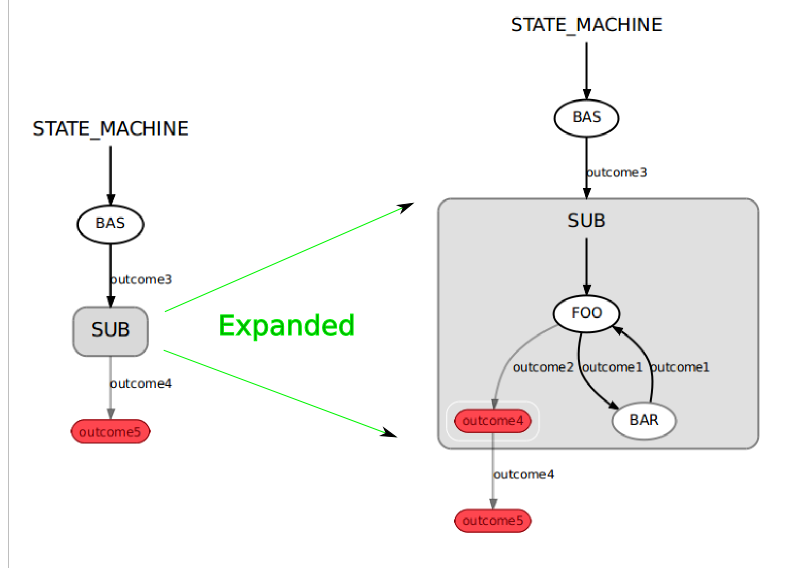| |
Create a Hierarchical State Machine
Description: This tutorial teaches you how to nest different state machines, creating a hierarchical state machine.Tutorial Level: BEGINNER
Next Tutorial: Calling Actions from a SMACH State Machine
Creating some states
For this example, we create a number of states, each with a number of outcomes, input keys and output keys specified.
1 # State Foo
2 class Foo(smach.State):
3 def __init__(self, outcomes=['outcome1', 'outcome2'])
4
5 def execute(self, userdata):
6 return 'outcome1'
7
8
9 # State Bar
10 class Bar(smach.State):
11 def __init__(self, outcomes=['outcome1'])
12
13 def execute(self, userdata):
14 return 'outcome4'
15
16
17 # State Bas
18 class Bas(smach.State):
19 def __init__(self, outcomes=['outcome3'])
20
21 def execute(self, userdata):
22 return 'outcome3'
Creating a hierarchical state machine
We create a top level state machine, and start adding states to it. One of the states we add is another state machine:
1 # Create the top level SMACH state machine
2 sm_top = smach.StateMachine(outcomes=['outcome5'])
3
4 # Open the container
5 with sm_top:
6
7 smach.StateMachine.add('BAS', Bas(),
8 transitions={'outcome3':'SUB'})
9
10 # Create the sub SMACH state machine
11 sm_sub = smach.StateMachine(outcomes=['outcome4'])
12
13 # Open the container
14 with sm_sub:
15
16 # Add states to the container
17 smach.StateMachine.add('FOO', Foo(),
18 transitions={'outcome1':'BAR',
19 'outcome2':'outcome4'})
20 smach.StateMachine.add('BAR', Bar(),
21 transitions={'outcome1':'FOO'})
22
23 smach.StateMachine.add('SUB', sm_sub,
24 transitions={'outcome4':'outcome5'})
The result looks like this. The only point to take away from this is that every state machine is also a normal state. So you can add a state machine to another state machine in the same way you add a state to a state machine. So dealing with userdata is not any different when you deal with hierarchical state machines: the sub state machine specifies input and output keys, and they get remapped when you add the sub state machine to the top level state machine.

Example
This is a complete runnable example from the executive_smach_tutorials package.
1 #!/usr/bin/env python
2
3 import roslib; roslib.load_manifest('smach_tutorials')
4 import rospy
5 import smach
6 import smach_ros
7
8 # define state Foo
9 class Foo(smach.State):
10 def __init__(self):
11 smach.State.__init__(self, outcomes=['outcome1','outcome2'])
12 self.counter = 0
13
14 def execute(self, userdata):
15 rospy.loginfo('Executing state FOO')
16 if self.counter < 3:
17 self.counter += 1
18 return 'outcome1'
19 else:
20 return 'outcome2'
21
22
23 # define state Bar
24 class Bar(smach.State):
25 def __init__(self):
26 smach.State.__init__(self, outcomes=['outcome1'])
27
28 def execute(self, userdata):
29 rospy.loginfo('Executing state BAR')
30 return 'outcome1'
31
32
33
34 # define state Bas
35 class Bas(smach.State):
36 def __init__(self):
37 smach.State.__init__(self, outcomes=['outcome3'])
38
39 def execute(self, userdata):
40 rospy.loginfo('Executing state BAS')
41 return 'outcome3'
42
43
44
45
46 def main():
47 rospy.init_node('smach_example_state_machine')
48
49 # Create the top level SMACH state machine
50 sm_top = smach.StateMachine(outcomes=['outcome5'])
51
52 # Open the container
53 with sm_top:
54
55 smach.StateMachine.add('BAS', Bas(),
56 transitions={'outcome3':'SUB'})
57
58 # Create the sub SMACH state machine
59 sm_sub = smach.StateMachine(outcomes=['outcome4'])
60
61 # Open the container
62 with sm_sub:
63
64 # Add states to the container
65 smach.StateMachine.add('FOO', Foo(),
66 transitions={'outcome1':'BAR',
67 'outcome2':'outcome4'})
68 smach.StateMachine.add('BAR', Bar(),
69 transitions={'outcome1':'FOO'})
70
71 smach.StateMachine.add('SUB', sm_sub,
72 transitions={'outcome4':'outcome5'})
73
74 # Execute SMACH plan
75 outcome = sm_top.execute()
76
77
78
79 if __name__ == '__main__':
80 main()
Running the example:
$ roscd smach_tutorials $ ./examples/state_machine_nesting2.py
The next tutorial teaches you how to call action servers from within a SMACH state machine.







